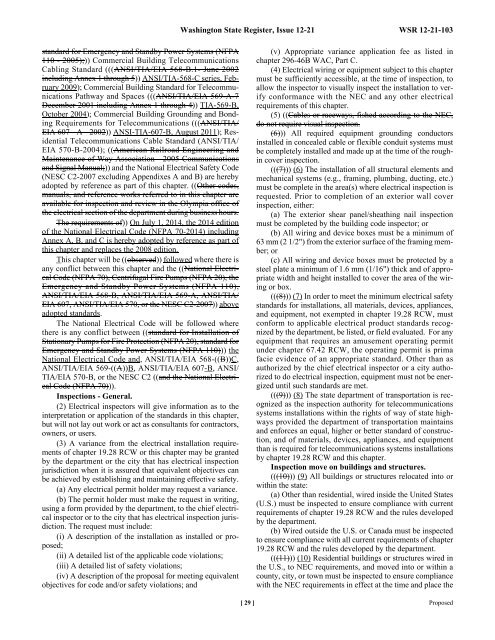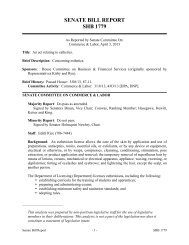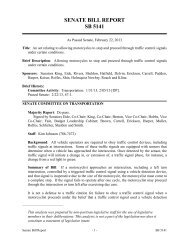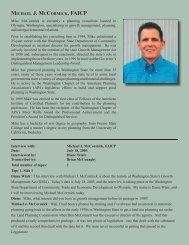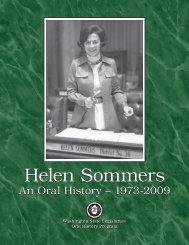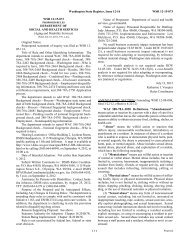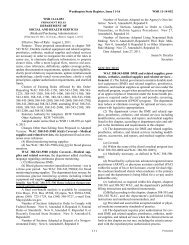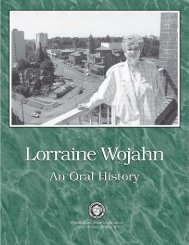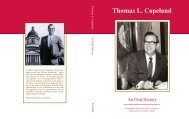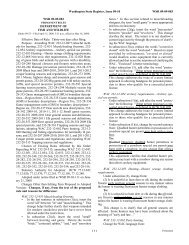Proposed
Proposed
Proposed
You also want an ePaper? Increase the reach of your titles
YUMPU automatically turns print PDFs into web optimized ePapers that Google loves.
standard for Emergency and Standby Power Systems (NFPA<br />
110 - 2005);)) Commercial Building Telecommunications<br />
Cabling Standard (((ANSI/TIA/EIA 568-B.1- June 2002<br />
including Annex 1 through 5)) ANSI/TIA-568-C series, February<br />
2009); Commercial Building Standard for Telecommunications<br />
Pathway and Spaces (((ANSI/TIA/EIA 569-A-7<br />
December 2001 including Annex 1 through 4)) TIA-569-B,<br />
October 2004); Commercial Building Grounding and Bonding<br />
Requirements for Telecommunications (((ANSI/TIA/<br />
EIA 607 - A - 2002)) ANSI-TIA-607-B, August 2011); Residential<br />
Telecommunications Cable Standard (ANSI/TIA/<br />
EIA 570-B-2004); ((American Railroad Engineering and<br />
Maintenance of Way Association - 2005 Communications<br />
and Signal Manual;)) and the National Electrical Safety Code<br />
(NESC C2-2007 excluding Appendixes A and B) are hereby<br />
adopted by reference as part of this chapter. ((Other codes,<br />
manuals, and reference works referred to in this chapter are<br />
available for inspection and review in the Olympia office of<br />
the electrical section of the department during business hours.<br />
The requirements of)) On July 1, 2014, the 2014 edition<br />
of the National Electrical Code (NFPA 70-2014) including<br />
Annex A, B, and C is hereby adopted by reference as part of<br />
this chapter and replaces the 2008 edition.<br />
This chapter will be ((observed)) followed where there is<br />
any conflict between this chapter and the ((National Electrical<br />
Code (NFPA 70), Centrifugal Fire Pumps (NFPA 20), the<br />
Emergency and Standby Power Systems (NFPA 110),<br />
ANSI/TIA/EIA 568-B, ANSI/TIA/EIA 569-A, ANSI/TIA/<br />
EIA 607, ANSI/TIA/EIA 570, or the NESC C2-2007)) above<br />
adopted standards.<br />
The National Electrical Code will be followed where<br />
there is any conflict between ((standard for Installation of<br />
Stationary Pumps for Fire Protection (NFPA 20), standard for<br />
Emergency and Standby Power Systems (NFPA 110))) the<br />
National Electrical Code and, ANSI/TIA/EIA 568-((B))C,<br />
ANSI/TIA/EIA 569-((A))B, ANSI/TIA/EIA 607-B, ANSI/<br />
TIA/EIA 570-B, or the NESC C2 ((and the National Electrical<br />
Code (NFPA 70))).<br />
Inspections - General.<br />
(2) Electrical inspectors will give information as to the<br />
interpretation or application of the standards in this chapter,<br />
but will not lay out work or act as consultants for contractors,<br />
owners, or users.<br />
(3) A variance from the electrical installation requirements<br />
of chapter 19.28 RCW or this chapter may be granted<br />
by the department or the city that has electrical inspection<br />
jurisdiction when it is assured that equivalent objectives can<br />
be achieved by establishing and maintaining effective safety.<br />
(a) Any electrical permit holder may request a variance.<br />
(b) The permit holder must make the request in writing,<br />
using a form provided by the department, to the chief electrical<br />
inspector or to the city that has electrical inspection jurisdiction.<br />
The request must include:<br />
(i) A description of the installation as installed or proposed;<br />
(ii) A detailed list of the applicable code violations;<br />
(iii) A detailed list of safety violations;<br />
(iv) A description of the proposal for meeting equivalent<br />
objectives for code and/or safety violations; and<br />
Washington State Register, Issue 12-21 WSR 12-21-103<br />
(v) Appropriate variance application fee as listed in<br />
chapter 296-46B WAC, Part C.<br />
(4) Electrical wiring or equipment subject to this chapter<br />
must be sufficiently accessible, at the time of inspection, to<br />
allow the inspector to visually inspect the installation to verify<br />
conformance with the NEC and any other electrical<br />
requirements of this chapter.<br />
(5) ((Cables or raceways, fished according to the NEC,<br />
do not require visual inspection.<br />
(6))) All required equipment grounding conductors<br />
installed in concealed cable or flexible conduit systems must<br />
be completely installed and made up at the time of the roughin<br />
cover inspection.<br />
(((7))) (6) The installation of all structural elements and<br />
mechanical systems (e.g., framing, plumbing, ducting, etc.)<br />
must be complete in the area(s) where electrical inspection is<br />
requested. Prior to completion of an exterior wall cover<br />
inspection, either:<br />
(a) The exterior shear panel/sheathing nail inspection<br />
must be completed by the building code inspector; or<br />
(b) All wiring and device boxes must be a minimum of<br />
63 mm (2 1/2") from the exterior surface of the framing member;<br />
or<br />
(c) All wiring and device boxes must be protected by a<br />
steel plate a minimum of 1.6 mm (1/16") thick and of appropriate<br />
width and height installed to cover the area of the wiring<br />
or box.<br />
(((8))) (7) In order to meet the minimum electrical safety<br />
standards for installations, all materials, devices, appliances,<br />
and equipment, not exempted in chapter 19.28 RCW, must<br />
conform to applicable electrical product standards recognized<br />
by the department, be listed, or field evaluated. For any<br />
equipment that requires an amusement operating permit<br />
under chapter 67.42 RCW, the operating permit is prima<br />
facie evidence of an appropriate standard. Other than as<br />
authorized by the chief electrical inspector or a city authorized<br />
to do electrical inspection, equipment must not be energized<br />
until such standards are met.<br />
(((9))) (8) The state department of transportation is recognized<br />
as the inspection authority for telecommunications<br />
systems installations within the rights of way of state highways<br />
provided the department of transportation maintains<br />
and enforces an equal, higher or better standard of construction,<br />
and of materials, devices, appliances, and equipment<br />
than is required for telecommunications systems installations<br />
by chapter 19.28 RCW and this chapter.<br />
Inspection move on buildings and structures.<br />
(((10))) (9) All buildings or structures relocated into or<br />
within the state:<br />
(a) Other than residential, wired inside the United States<br />
(U.S.) must be inspected to ensure compliance with current<br />
requirements of chapter 19.28 RCW and the rules developed<br />
by the department.<br />
(b) Wired outside the U.S. or Canada must be inspected<br />
to ensure compliance with all current requirements of chapter<br />
19.28 RCW and the rules developed by the department.<br />
(((11))) (10) Residential buildings or structures wired in<br />
the U.S., to NEC requirements, and moved into or within a<br />
county, city, or town must be inspected to ensure compliance<br />
with the NEC requirements in effect at the time and place the<br />
[ 29 ] <strong>Proposed</strong>


